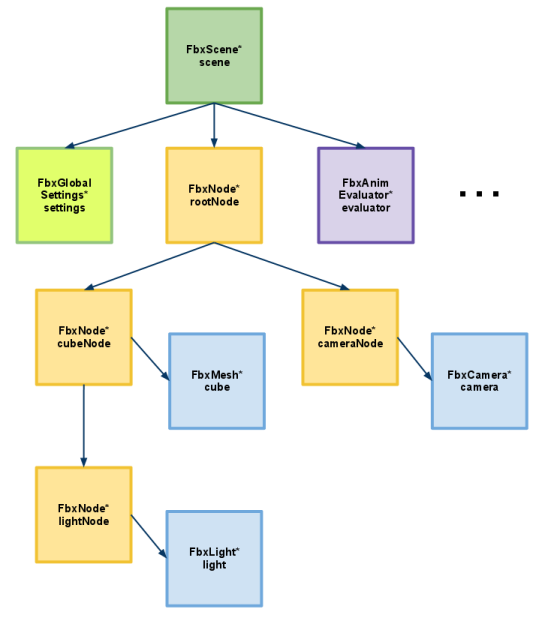FBX Scenes
Scene Graph Organization Summary
The FBX SDK scene graph is abstracted by the FbxScene class. The scene is organized as a hierarchy of nodes (FbxNode). The root node of the scene is accessed via FbxScene::GetRootNode(). A scene element, for example, a mesh, a light, or a camera is defined by combining a FbxNode with a subclass of FbxNodeAttribute. For more information, see FBX Nodes and FBX Node Attributes.

Creating a Scene
As illustrated in Managing Memory with the FBX SDK Manager, a FbxScene is created by invoking the FbxScene::Create() function. A new FbxScene contains a root FbxNode, and a FbxGlobalSettings object with a default configuration.
// Create the SDK manager. FbxManager* lSdkManager = FbxManager::Create(); // Create the scene. FbxScene* lScene = FbxScene::Create(lSdkManager, "Scene Name");
Scene elements are created using a reference to the FbxScene in which they belong. In doing so, the scene will be exported with all the elements which were created with it. In the following sample, a node is created with a reference to the FbxScene, and attached to the root node of the scene.
// Get the root node of the scene. FbxNode* lRootNode = lScene->GetRootNode(); // Create a child node. FbxNode* lChild = FbxNode::Create(lScene, "child"); // Add the child to the root node. lRootNode->AddChild(lChild);
Global Scene Settings
The scene's axis system, system units, ambient lighting, and time settings are defined in its FbxGlobalSettings object. This object is accessed via FbxScene::GetGlobalSettings().
Animation Evaluation
The scene's FbxAnimEvaluator evaluates the animated geometric transformations of each node in the scene at a specific time. It also evaluates any other animatable property of the scene, for example, the color change of a specific material. The scene's FbxAnimEvaluator is accessed via FbxScene::GetEvaluator(). For more information, see Animation.
Texture and Material Management
The materials (FbxSurfaceMaterial) and textures (FbxTexture) created within the scene can be accessed and modified using member functions such as FbxScene::GetMaterial() and FbxScene::GetTexture(). For more information on using materials and textures with meshes, see Meshes, Materials and Textures.
Characters and Character Pose Management
Characters (FbxCharacter), and character poses (FbxCharacterPose) within the scene can be accessed using FbxScene::GetCharacter() and FbxScene::GetCharacterPose(). Consult the class documentation of FbxCharacter and FbxCharacterPose for more information on how to define characters in a scene.
Topics in this section
- Merging Two Scenes
This topic presents how to merge two imported scenes. It also provides basic insight on manipulating a scene and the nodes within it, and will initiate the reader to the concept of connections and connection management.
- Scene Axis and Unit Conversion
